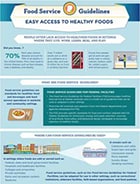At a glance
Food service guidelines are standards for healthier food, beverages, and food service operations in worksite and community settings. This page addresses food service guidelines topics such as the benefits, settings and venues, successful program examples, and resources.

Potential benefits
Food service guidelines help create a healthy food environment. The guidelines may:
- Contribute to health and wellness of employees and visitors.
- Create expectations for healthier food and beverage availability.
- Strengthen local food systems.
- Improve facility management of natural resources.
- Increase energy efficiency.
- Reduce harmful environmental impact.
Aligning food service guidelines
The food and nutrition standards for any food service guidelines should align with the current version of the Dietary Guidelines for Americans. If your food service guidelines do not align, update them or switch to the Food Service Guidelines for Federal Facilities.
The Food Service Guidelines for Federal Facilities is one of the most comprehensive guidelines available. It includes standards for:
- Food and nutrition.
- Facility efficiency.
- Environmental support.
- Community development.
- Food safety.
- Behavioral design.
Written for use at federal facilities, this model set of guidelines can be readily used in public and private settings within your state or community. See Food Service Guidelines for Federal Facilities: A Model for Your State or Community.
Where to use food service guidelines
In settings such as:
- Federal, state, local, and tribal government facilities.
- Hospitals and health care facilities.
- Colleges and universities.
- Private worksites.
- Parks and recreation centers.
- Stadiums.
- Military bases.
- Correctional institutions.
In venues such as:
- Cafeterias and cafés.
- Snack bars and grills.
- Concession stands.
- Micro markets.
- Sundry shops.
- Vending machines.
Examples of successful programs
The 2019 Food Service Guidelines Local Action Institute brought together diverse teams to develop a plan that makes healthier food service and procurement practices a reality. Read about the positive impact in New York, Oregon, and Pennsylvania.
- The videos below highlight the story of a local YMCA in Kershaw, Alabama that worked to bring healthier snack options to their concessions program serving children and staff.
- The videos below showcase Colorado’s Healthy Hospital Compact, a statewide recognition program run by the Colorado Department of Public Health & Environment. The recognition program ensures Colorado hospitals have healthy and sustainable food service operations that support the health of patients, employees, and visitors.
Resources
![]()
![]()
The Food Service Guidelines Implementation Toolkit explains how to build a foundation; strategize and act; monitor and evaluate; and expand initiatives.

Food Service Guidelines: Easy Access to Healthy Food [PDF-2.5MB] is a two-page infographic that explains food service guidelines. Share the link or print the PDF to show decision-makers in your community or institution.

The CDC’s Food Service Guidelines Policy [PDF-290KB] helps to create a healthier food environment at CDC and supports the health and well-being of its employees. The organizational policy provides direction and requirements to ensure that all new and renegotiated food service contracts and permits at CDC meet the standards outlined in the current Food Service Guidelines for Federal Facilities [PDF – 3.34 MB].

Tips For Offering Healthier Options and Physical Activity at Workplace Meetings and Events [PDF-665KB] includes pointers and resources for increasing healthier food and beverage options at worksite meetings, parties, conferences, and events and for offering physical activity opportunities for employees throughout the work day.

What is the Evidence for State and Local Laws Addressing Sodium Reduction among the US Adult Population? [PDF 5.1MB] is an evidence report that assesses the strength and quality of six policy interventions to reduce sodium consumption among adults.
Learning modules
Food Service Guidelines Micro-Learning Modules: Short educational videos that describe effective food service guidelines policies and how to put them into practice in your community. This series was created in close collaboration with nutrition policy experts at the National Association of County and City Health Officials (NACCHO) and CDC's Division of Nutrition, Physical Activity, and Obesity.
